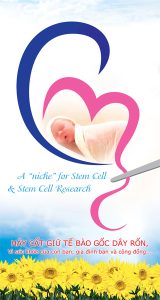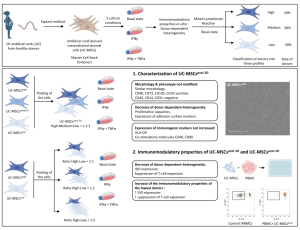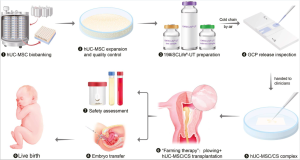Parent’s Guide to Cord Blood, October 2023
The following story was reported in May 2023 at the 10th cord blood conference of the China Maternal and Child Health Association1-3. The patient has been given the pseudonym “Xiao An”. In Chinese, “Xiao” is a gender-neutral name that is often translated as “dawn”, “little”, and “reverent of the elderly.” “I didn’t expect that the umbilical cord blood saved for the child would actually save the child’s life 19 years later!” said the father of Xiaoan, an aplastic anemia patient, excitedly. In 2021, 18-year-old Xiao An suddenly suffered from aplastic anemia. Fortunately, the cord blood stored in Tianjin Umbilical Cord Blood Hematopoietic Stem Cell Bank under Zhongyuan Concorde saved his life and he is recovering well. This is by far the longest storage of autologous cord blood used for therapy in China, creating a new record for self-storage and self-use of cord blood in China.
Every time Xiaoan’s parents recalled their decision to preserve their cord blood, they felt extremely grateful. When Xiaoan was born in 2003, domestic awareness of umbilical cord blood was still in its infancy. With the mentality of “preparation, multiple guarantees, and multiple peace of mind”, they stored the umbilical cord blood for their children. It was this seed of life from Xiaoan himself that brought the fire of life back to him 19 years later. In December 2021, Xiaoan, who had just turned 18, suddenly developed symptoms such as ulcers and blood spots. After a series of examinations, Xiaoan was diagnosed with aplastic anemia. Aplastic Anemia is an auto-immune condition where over-reactive T-cells in the blood have been triggered to attack the body’s own bone marrow. Xiaoan also had “PNH clones” in the blood (paroxysmal nocturnal hemoglobinuria), which is a hallmark of severe aplastic anemia. This severe attack can lead to complete bone marrow failure and death. While seeking treatment in many domestic hospitals, Xiaoan’s parents learned that: At present, umbilical cord blood hematopoietic stem cell transplantation is one of the effective methods for treating aplastic anemia, and the cure rate of cord blood transplants with the patient’s own autologous cord blood is high. This gave Xiaoan’s family, who had been shrouded in the haze of the disease, a new light of hope, because as early as 2003, when the child was born, Xiaoan’s parents had stored umbilical cord blood hematopoietic stem cells for the child in the Tianjin Cord Blood Bank.
After Xiaoan’s treatment plan for autologous umbilical cord blood transplantation was determined, the hospital and Xiaoan’s parents contacted Tianjin Cord Blood Bank as soon as possible. Upon receiving the news, the staff of the cord blood bank immediately devoted themselves to the preparations for the release of the cord blood. Re-examination by professional technicians showed that the umbilical cord blood hematopoietic stem cells that had been “sleeping” for 19 years were in good condition, and all indicators met the release standards. In December 2022, Xiaoan was transferred to Beijing Lu Daopei Hospital, a well-known specialized hospital for blood diseases in the country, and was officially prepared to receive a stem cell transplant. With the efforts of the staff, the precious cord blood was successfully delivered to the transplantation hospital. December 25, 2022 is of great significance to Xiaoan’s family. After the all-out treatment by Director Xiong Min of Beijing Lu Daopei Hospital, Xiaoan underwent reinfusion of umbilical cord blood hematopoietic stem cells on the same day, and this precious seed of life returned to the owner smoothly. About a month later, Xiaoan was released from intensive care, and all physical indicators recovered well. He was discharged from the hospital in February of 2023 and returned to normal life. Xiao An is unfortunate, but also “lucky”. Talking about the child’s illness and treatment experience, Xiao An’s parents are very grateful for storing the umbilical cord blood for the child. Umbilical cord blood is the blood collected from the umbilical vein after the baby is born and the umbilical cord is severed. It is rich in blood-forming “hematopoietic” stem cells and is of great help in the treatment of blood diseases. At present, with the continuous development of medical technology, umbilical cord blood has clinical application value in more than 80 diseases of the blood system and the metabolism. The popularization of umbilical cord blood storage technology will provide health protection for more families.
In Xiaoan’s treatment case, autologous cord blood played a positive role. At the same time, the mature storage technology and safety guarantee of Tianjin Cord Blood Bank have also been unanimously recognized by clinical experts. The autologous transplant successfully rekindled life across 19 years of time and space, and also guarded a healthy and happy future for a family. Xiaoan’s father said sincerely in an interview after the operation: “I am very grateful to the hospital and doctors who treated Xiaoan. Thanks to the Tianjin Cord Blood Bank. You have really benefited mankind and benefited thousands of families. This is a great cause!” It is reported that the Tianjin Cord Blood Bank was established in 2001, and the first privately stored cord blood stem cells in China were frozen in the same year. The Tianjin bank was among the first batch of hematopoietic stem cell banks approved by the former Ministry of Health in China, and has passed the practice inspection. It is also an important part of the national stem cell engineering product industrialization base approved by the National Development and Reform Commission. Currently, the library of the Tianjin Cord Blood Bank records more than 3,400 application cases of cord blood units from the bank.
Disclaimer: In most countries, it is the policy of the medical community to try to find an unrelated donor for a patient with Aplastic Anemia. This is the case in the United States and in India. However, if an unrelated donor is not available, and if the Aplastic Anemia is considered to be “acquired” (triggered by a virus, and not due to inborn genetics), then doctors may restore the immune system that the patient had at birth by transplanting the patient’s own cord blood stem cells. Another example of this therapy is the story of Henrique in Portugal.
References
- Tianjin Cord Blood Bank. Nineteen years like a day, holding up the “seed of life”. Concord News. Published 2020-02-28
- Beijing Cord Blood Bank. 19 years! The longest record of autologous cord blood storage and application in my country was born. Company News. Published 2023-05-22
- A new breakthrough in the application of umbilical cord blood! A 19-year-old patient with severe aplastic anemia was successfully transplanted with autologous cord blood, “rebooting” his vitality and youth! Weixin (Weixin is WeChat for PRC users). Published 2023-05-25
Source: Parent’s Guide to Cord Blood
Link: https://parentsguidecordblood.org/en/news/cured-his-own-cord-blood-19-years-later









